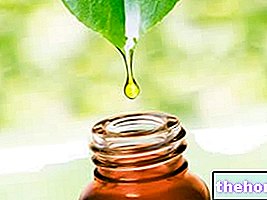it consists of dried flower heads.
(alphabisabolol and its oxides, chamazulene, guaiazulene, cerulene, farnesene);
In addition to the extracts titrated and standardized in active substances used above all to relieve symptoms and disorders of the digestive system, chamomile - or rather, its dried flower heads - are used in the home for the preparation of infusions.
For external use, on the other hand, chamomile extracts are recommended above all in products applied to inflamed, delicate, sensitive, irritated, acne-prone skin, with couperose or boils, thanks to the local anti-inflammatory properties ascribed to the plant.
Please Note
Common or German chamomile should NOT be confused with Roman chamomile (Anthemis nobilis). More detailed information can be found in the dedicated article.
Biological activity
The properties of which chamomile is endowed are conferred by the essential oil (in particular, by the chamazulene and by the alpha-bisabolol contained in it) and by the flavonoids (among which apigenin stands out) present within it.
Thanks to the action of these compounds, chamomile is used for the treatment of inflammation and irritation of various kinds and nature and for the treatment of inflammatory affections of the gastrointestinal tract associated with spasms.
The anti-inflammatory properties of chamomile are attributable to the apigenin and the chamazulene contained in its essential oil. In fact, some studies have shown that chamazulene is able to inhibit the synthesis of leukotriene B4 (a particular type of leukotriene involved in inflammatory processes ), while apigenin is able to reduce leukocyte adhesion to endothelial cells that occurs during inflammation. It is therefore believed that these mechanisms of action are involved in the anti-inflammatory effect traditionally ascribed to chamomile.
Alpha-bisabolol, on the other hand, seems to be directly responsible for the effects that chamomile has on the gastrointestinal tract. This substance - which is found inside the essential oil - is able to reduce the proteolytic activity of pepsin in the stomach. , while flavonoids help reduce any inflammatory states.
The properties of chamomile, however, do not end there. In fact, numerous researches have been conducted on the other possible activities exerted by the flavonoids it contains and, in particular, by the "apigenin".
From the various studies carried out it emerged that apigenin is also able to bind to the same receptor site as benzodiazepines, thus exerting a mild sedative and anxiolytic action.
The potential antitumor activity of apigenin was also investigated. From the studies conducted it emerged that the topical application of apigenin may be useful in preventing the transformation of skin papillomas into carcinomas. Clearly, despite the encouraging results, further and in-depth studies are needed.
Chamomile against inflammation
As mentioned, thanks to the essential oil and the flavonoids contained in it, chamomile can be used in the treatment of inflammatory states of various kinds.
Chamomile is used orally to counteract inflammation of the gastrointestinal tract, oropharyngeal mucosa and upper airways.
When administered topically, however, chamomile is used as a remedy against inflammation of the mucous membranes, gingivitis and pulpits. In this regard, for external use it is possible to prepare a solution for compresses by infusing two tablespoons of chamomile in hot water for about fifteen minutes.
Chamomile against Gastrointestinal Spasms
Thanks to the properties of alpha-bisabolol and the flavonoids contained in chamomile, this plant can be used internally to treat gastrointestinal disorders associated with spasms.
Chamomile tea can be taken in the form of an infusion; alternatively, on the market there are products for oral use that can be used for these purposes (for example, mother tincture, liquid extract, etc.).
PLEASE NOTE
When using products containing chamomile for therapeutic-like purposes, it is essential to use defined and standardized preparations in active ingredients, since only in this way can you know the exact amount of active substances you are taking.
When chamomile-based preparations are used, the doses of product to be taken may vary according to the quantity of active substances contained. This quantity is usually reported directly by the manufacturing company on the package or on the package leaflet of the same product, therefore, for the administration of the product, it is very important to follow the instructions provided by it.
In any case, before taking any type of preparation containing chamomile, it is advisable to contact your doctor in advance, in order to exclude any contraindications to the use of the same (for example, allergies, pharmacological therapies in place that are not compatible with the intake of chamomile extracts, pregnancy, breastfeeding, etc.).
To learn more, read also: Properties of Chamomile
Chamomile in Folk Medicine and Homeopathy
In folk medicine, chamomile is used internally as a remedy for flatulence and diarrhea; while it is used externally to treat hemorrhoids, abscesses and acne.
In homeopathy, on the other hand, chamomile is used as a remedy against gastrointestinal inflammations and spasms, against inflammation of the upper respiratory tract and against dysmenorrhea.
In addition, chamomile is also used in the homeopathic field to treat teething disorders in babies and children and to treat painful states in general.
Chamomile is readily available in homeopathic preparations in the form of solutions or granules. The dose of product to be taken may vary according to the homeopathic dilution used.
PLEASE NOTE
The applications of chamomile for the treatment of the aforementioned disorders in the context of the aforementioned alternative medicines are neither approved nor supported by the appropriate experimental tests, or have not passed them. For this reason, they could be without therapeutic efficacy or even be harmful. for your health It is advisable to always consult your doctor.
increasing the risk of bleeding. At the same time, chamomile may enhance the effect of benzodiazepines or other sedative drugs.Therefore, if you are undergoing drug therapies, it is advisable to consult your doctor before taking products containing chamomile extracts.
following the use of chamomile, both internally and externally. In the latter case, allergic dermatitis or conjunctivitis may also appear.
In some cases one could witness the purchase of a paradoxical effect with the onset of insomnia; however, this condition can occur mainly following the consumption of chamomile in high doses, or following its abuse.




























